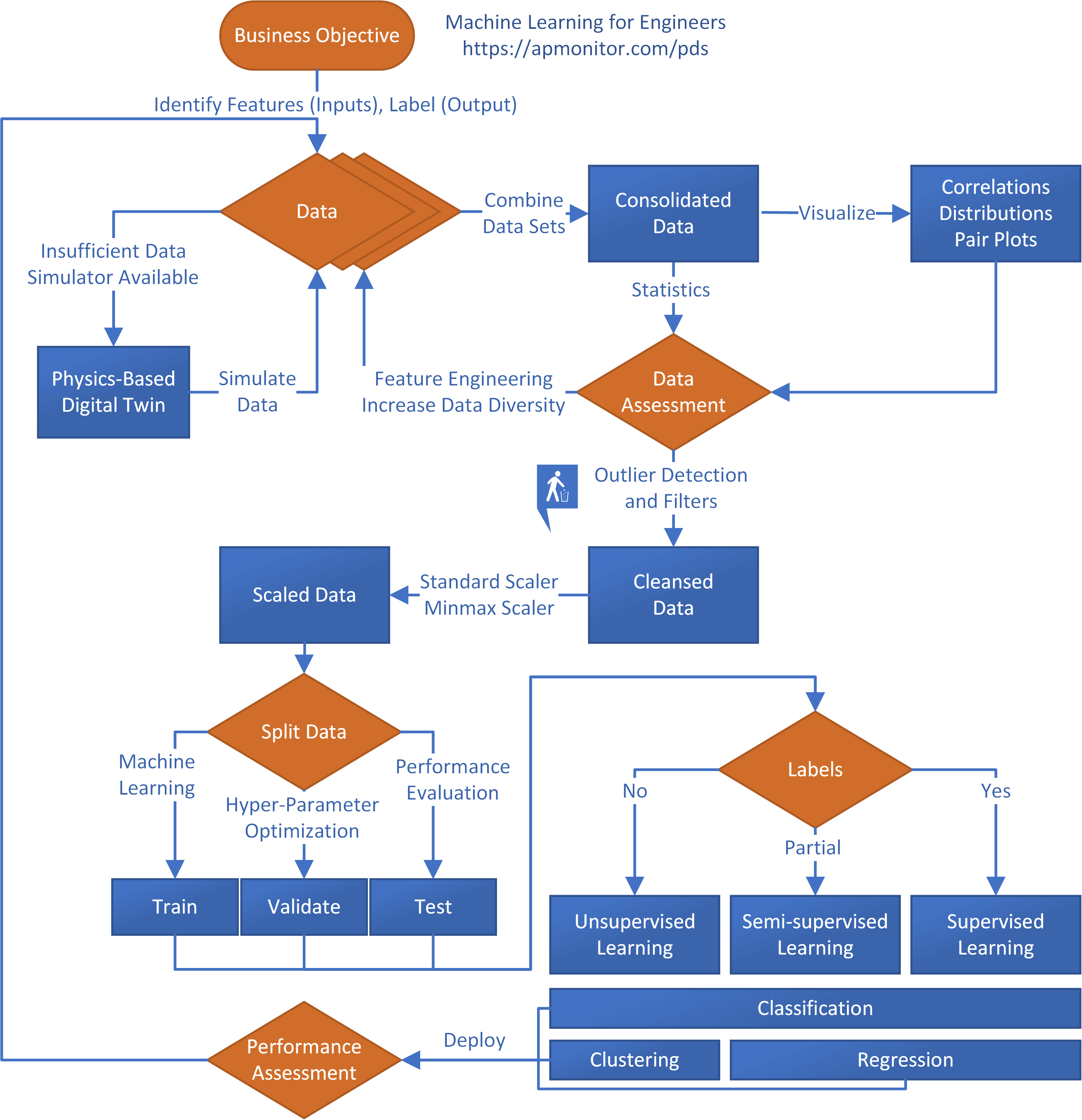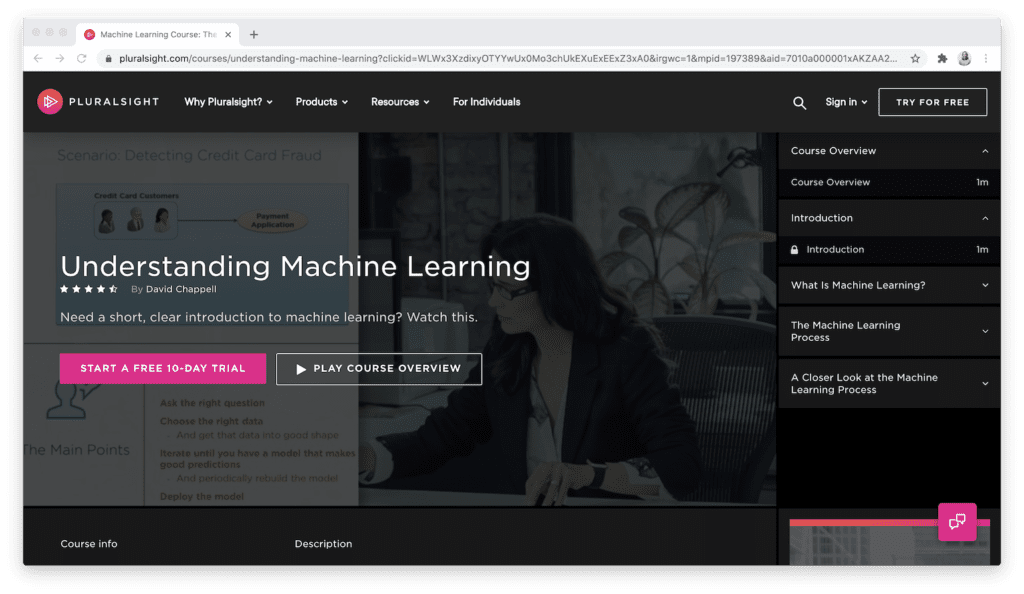All Categories
Featured
Table of Contents
- – The Ultimate Guide To Computational Machine Le...
- – Getting My Machine Learning Engineer Course To...
- – Unknown Facts About Certificate In Machine Le...
- – Getting The Best Online Machine Learning Cour...
- – All about Machine Learning (Ml) & Artificial...
- – Some Of Machine Learning Course
- – Getting My Top Machine Learning Careers For ...
Some individuals believe that that's cheating. Well, that's my whole career. If someone else did it, I'm mosting likely to use what that person did. The lesson is putting that aside. I'm forcing myself to think through the possible solutions. It's even more regarding taking in the content and trying to apply those concepts and less concerning discovering a collection that does the job or searching for someone else that coded it.
Dig a little bit deeper in the math at the start, so I can construct that foundation. Santiago: Lastly, lesson number seven. This is a quote. It claims "You have to recognize every information of an algorithm if you desire to use it." And then I claim, "I assume this is bullshit advice." I do not think that you need to comprehend the nuts and bolts of every formula before you use it.
I have actually been making use of semantic networks for the longest time. I do have a feeling of how the gradient descent works. I can not describe it to you today. I would have to go and check back to actually obtain a much better intuition. That doesn't imply that I can not resolve points making use of semantic networks, right? (29:05) Santiago: Trying to compel individuals to think "Well, you're not going to succeed unless you can describe every solitary information of how this works." It returns to our sorting instance I believe that's just bullshit suggestions.
As a designer, I have actually serviced several, many systems and I have actually used several, numerous points that I do not recognize the nuts and screws of exactly how it works, although I understand the impact that they have. That's the final lesson on that particular string. Alexey: The amusing thing is when I believe concerning all these libraries like Scikit-Learn the formulas they use inside to carry out, for instance, logistic regression or another thing, are not the like the algorithms we research in artificial intelligence courses.
The Ultimate Guide To Computational Machine Learning For Scientists & Engineers
So even if we tried to find out to get all these basics of artificial intelligence, at the end, the formulas that these libraries use are different. ? (30:22) Santiago: Yeah, definitely. I believe we need a lot a lot more materialism in the industry. Make a great deal even more of an impact. Or focusing on delivering value and a bit much less of purism.

By the method, there are two various courses. I typically talk with those that wish to operate in the market that intend to have their effect there. There is a path for researchers which is totally different. I do not risk to discuss that because I don't understand.
Right there outside, in the sector, materialism goes a lengthy means for sure. Santiago: There you go, yeah. Alexey: It is a great inspirational speech.
Getting My Machine Learning Engineer Course To Work
One of the things I wanted to ask you. Initially, allow's cover a couple of things. Alexey: Allow's start with core tools and frameworks that you need to learn to in fact shift.
I know Java. I know SQL. I recognize exactly how to utilize Git. I know Bash. Possibly I know Docker. All these things. And I listen to about artificial intelligence, it appears like an awesome thing. So, what are the core devices and structures? Yes, I viewed this video clip and I get encouraged that I do not require to obtain deep right into mathematics.
What are the core tools and frameworks that I need to find out to do this? (33:10) Santiago: Yeah, definitely. Great question. I assume, leading, you should begin discovering a little of Python. Since you currently understand Java, I don't think it's going to be a significant change for you.
Not due to the fact that Python is the same as Java, yet in a week, you're gon na obtain a lot of the differences there. You're gon na be able to make some development. That's top. (33:47) Santiago: Then you get specific core devices that are mosting likely to be utilized throughout your whole job.
Unknown Facts About Certificate In Machine Learning
You get SciKit Learn for the collection of maker knowing algorithms. Those are tools that you're going to have to be using. I do not suggest just going and learning concerning them out of the blue.
We can talk concerning particular programs later. Take among those programs that are mosting likely to begin presenting you to some problems and to some core ideas of maker learning. Santiago: There is a training course in Kaggle which is an intro. I do not bear in mind the name, but if you most likely to Kaggle, they have tutorials there free of cost.
What's good about it is that the only demand for you is to understand Python. They're mosting likely to present a problem and inform you just how to use decision trees to address that particular trouble. I think that procedure is exceptionally effective, because you go from no device discovering background, to comprehending what the trouble is and why you can not address it with what you know right currently, which is straight software design methods.
Getting The Best Online Machine Learning Courses And Programs To Work
On the various other hand, ML designers concentrate on building and releasing artificial intelligence models. They concentrate on training designs with data to make forecasts or automate tasks. While there is overlap, AI engineers take care of more diverse AI applications, while ML engineers have a narrower concentrate on equipment knowing algorithms and their useful implementation.

Artificial intelligence engineers focus on developing and releasing machine discovering models into production systems. They deal with engineering, making sure models are scalable, reliable, and integrated right into applications. On the other hand, information researchers have a more comprehensive duty that includes information collection, cleaning, expedition, and building versions. They are typically in charge of removing insights and making data-driven decisions.
As organizations significantly take on AI and maker discovering technologies, the demand for skilled specialists expands. Maker understanding engineers function on innovative tasks, add to innovation, and have affordable salaries.
ML is fundamentally different from standard software application development as it concentrates on mentor computer systems to gain from data, as opposed to programs explicit guidelines that are performed methodically. Unpredictability of results: You are possibly made use of to composing code with foreseeable outputs, whether your function runs as soon as or a thousand times. In ML, however, the results are less specific.

Pre-training and fine-tuning: Exactly how these models are trained on vast datasets and after that fine-tuned for certain tasks. Applications of LLMs: Such as text generation, sentiment analysis and details search and access. Papers like "Interest is All You Need" by Vaswani et al., which introduced transformers. Online tutorials and courses concentrating on NLP and transformers, such as the Hugging Face course on transformers.
All about Machine Learning (Ml) & Artificial Intelligence (Ai)
The capability to handle codebases, merge changes, and solve disputes is equally as important in ML advancement as it remains in traditional software application projects. The skills developed in debugging and screening software program applications are extremely transferable. While the context could change from debugging application logic to recognizing concerns in information handling or version training the underlying principles of systematic examination, theory testing, and iterative improvement are the same.
Machine discovering, at its core, is heavily dependent on data and probability theory. These are critical for understanding how algorithms learn from data, make predictions, and evaluate their efficiency.
For those thinking about LLMs, a complete understanding of deep knowing designs is useful. This includes not just the mechanics of semantic networks however also the style of particular versions for various use situations, like CNNs (Convolutional Neural Networks) for picture processing and RNNs (Frequent Neural Networks) and transformers for consecutive information and natural language processing.
You ought to understand these concerns and learn techniques for recognizing, reducing, and interacting about bias in ML designs. This includes the potential effect of automated decisions and the moral ramifications. Lots of designs, specifically LLMs, require substantial computational sources that are typically supplied by cloud platforms like AWS, Google Cloud, and Azure.
Building these abilities will certainly not just facilitate an effective change right into ML yet additionally make sure that developers can contribute efficiently and sensibly to the innovation of this vibrant field. Theory is necessary, yet absolutely nothing defeats hands-on experience. Beginning dealing with projects that enable you to apply what you have actually learned in a functional context.
Join competitions: Sign up with systems like Kaggle to take part in NLP competitors. Construct your jobs: Start with basic applications, such as a chatbot or a text summarization device, and progressively boost complexity. The area of ML and LLMs is quickly developing, with brand-new developments and modern technologies arising routinely. Remaining upgraded with the most current research and patterns is essential.
Some Of Machine Learning Course
Contribute to open-source tasks or write blog posts concerning your discovering trip and jobs. As you acquire competence, start looking for opportunities to include ML and LLMs right into your work, or look for brand-new duties concentrated on these innovations.

Possible usage situations in interactive software application, such as recommendation systems and automated decision-making. Comprehending unpredictability, basic statistical actions, and chance distributions. Vectors, matrices, and their role in ML formulas. Mistake minimization methods and gradient descent explained just. Terms like version, dataset, features, labels, training, reasoning, and validation. Information collection, preprocessing methods, design training, analysis processes, and implementation considerations.
Choice Trees and Random Forests: Instinctive and interpretable versions. Matching trouble kinds with suitable versions. Feedforward Networks, Convolutional Neural Networks (CNNs), Frequent Neural Networks (RNNs).
Continuous Integration/Continuous Release (CI/CD) for ML workflows. Design monitoring, versioning, and efficiency tracking. Identifying and resolving changes in model efficiency over time.
Getting My Top Machine Learning Careers For 2025 To Work

You'll be presented to 3 of the most pertinent elements of the AI/ML technique; supervised understanding, neural networks, and deep discovering. You'll grasp the distinctions between conventional programs and equipment discovering by hands-on advancement in supervised discovering prior to building out complex dispersed applications with neural networks.
This training course functions as a guide to machine lear ... Program Much more.
Table of Contents
- – The Ultimate Guide To Computational Machine Le...
- – Getting My Machine Learning Engineer Course To...
- – Unknown Facts About Certificate In Machine Le...
- – Getting The Best Online Machine Learning Cour...
- – All about Machine Learning (Ml) & Artificial...
- – Some Of Machine Learning Course
- – Getting My Top Machine Learning Careers For ...
Latest Posts
How To Use Youtube For Free Software Engineering Interview Prep
The Best Python Courses For Data Science & Ai Interviews
The Best Faang Interview Preparation Courses In 2025
More
Latest Posts
How To Use Youtube For Free Software Engineering Interview Prep
The Best Python Courses For Data Science & Ai Interviews
The Best Faang Interview Preparation Courses In 2025